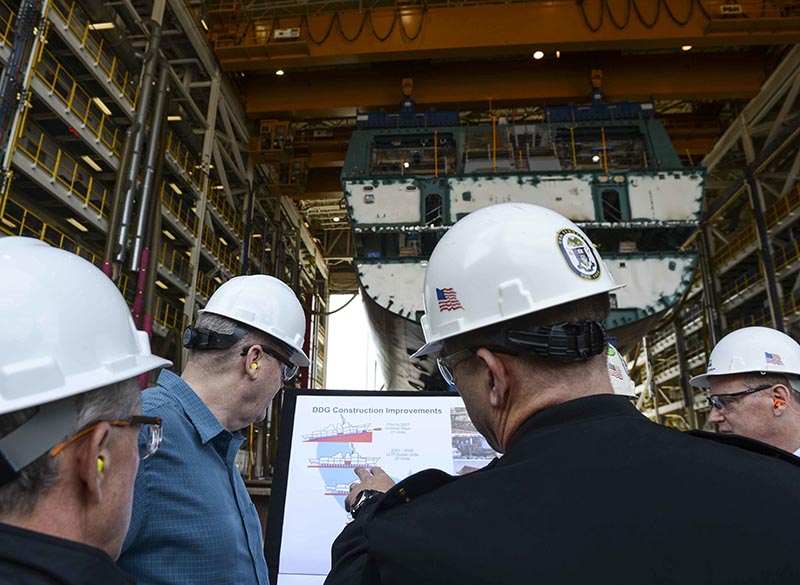(Bloomberg) — America needs more warships — and must build them faster — to keep up with other countries that are spending heavily on maritime prowess, according to the U.S. Navy’s chief of operations.
“Pace is an important part of our current world environment, including the security environment,” Admiral John Richardson said Tuesday at a briefing in Singapore. “We have to be mindful that that environment is moving forward at a particular pace and if we’re going to remain competitive we’d better pick up that pace and match it at least, if not exceed it.”
Richardson was speaking ahead of the release this week of a Navy white paper, which will outline its future requirements after an era of budgetary constraints. Richardson said in April that shipbuilders should speed up designs to cut the time by as much as half, according to the Breaking Defense news site.
“We are getting back into, after decades really, an era of maritime competition,” Richardson said, adding moves by China to match its economic clout with military sway should not be seen as alarming. “At some point you turn to the sea to expand and continue to prosper.”
U.S. President Donald Trump is set to release his fiscal 2018 budget next week. He has pledged previously to expand the Navy’s fleet to 350 vessels from 275 now.
Trump has created unease among some allies and smaller states in Asia over whether he will continue predecessor Barack Obama’s military rebalancing to the region, which included beefing up the U.S. naval presence in the disputed South China Sea. At the same time, China is ramping up spending on its military and recently launched its second aircraft carrier.
‘Credible Options’
“If you look at just the geography, wherever we are engaged today, where we are involved today, you can see that there is a size part of that,” Richardson said. “To provide credible options, to provide partnering opportunities, you need to be there. Numbers are a part of that solution.”
The Navy has sent the Carl Vinson carrier group to North Asia, where it has conducted exercises with Japan and other countries at a time of heightened tensions with North Korea.
But while it carries a full complement of weaponry, including scores of Tomahawk cruise and anti-ship missiles, radar-jamming aircraft and non-stealthy F-18 Super Hornet jets built by Boeing Co., it can’t shoot down ballistic missiles.
“We need to be building a navy that is not only larger — all of the studies that have taken place over the past year or so pretty much agree with that — but it’s also got to be better,” Richardson said. “It’s not just about numbers, platforms, it’s also about what those platforms can do and then again how they all work together.”
‘More Lethal’

The littoral combat ship Montgomery. Austal USA photo.
Richardson defended the littoral combat ship program, after two defense secretaries under Obama questioned if the light ship intended for shallow coastal waters could survive in combat and then cut back the numbers planned. The navy has often had an LCS operating out of Singapore into the South China Sea.
“The LCS program is improving almost by the day, it’s becoming stronger, more lethal, more survivable, more reliable,” Richardson said. “It embodied this idea of modularity and the ability to improve over its life. We need to take that to the next level. The technology has moved, even since we designed and built the first LCSs.”
The LCS and its successor frigate would be one path to deliver on Trump’s pledge to expand the fleet. Still, the Navy will delay by at least a year plans to award a multibillion-dollar construction contract for a frigate meant to succeed the LCS, service officials said earlier this month.
Regional Stability
“There is a lot of discussion about small-surface combatants, littoral combat ships transitioning to frigates at some point,” Richardson said. “That will be an opportunity for us to step into this new regime, if you will, of building ships that are fundamentally built to modernize over their life.”
Singapore is also bolstering its navy. Defense Minister Ng Eng Hen said on Tuesday the country would buy two more submarines to be operational by 2024, adding to two already on order, as it seeks to replace its older fleet.
Richardson also attended the International Maritime Security Conference while in Singapore on Tuesday. Mohamad Maliki Osman, Singapore’s senior minister of state for defense and foreign affairs, told the gathering that cooperation was needed to avoid miscalculation amid the military build-up in the region.
“The U.S.-China relationship is the single most important factor that underscores stability in the region,” Maliki said. “Strategic cooperation between the U.S. and China over issues such as North Korea brings stability to the region.”
Bloomberg News by Rosalind Mathieson




